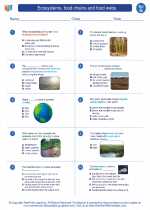Celestial Objects
Celestial objects are natural objects that are located in the sky and beyond the Earth's atmosphere. These objects include stars, planets, moons, asteroids, comets, and galaxies. Studying celestial objects helps us understand the vastness of the universe and the forces that govern it.
Types of Celestial Objects
- Stars: These are massive, luminous spheres of plasma held together by gravity. They emit light and heat due to nuclear reactions happening in their cores.
- Planets: These are large celestial bodies that orbit around a star. They do not produce their own light but reflect light from the star they orbit.
- Moons: Moons are natural satellites that orbit planets. They vary in size and composition.
- Asteroids: These are small, rocky objects that orbit the Sun, mostly found in the asteroid belt between Mars and Jupiter.
- Comets: Comets are icy bodies that release gas and dust as they approach the Sun, often developing a visible tail.
- Galaxies: A galaxy is a huge collection of gas, dust, and billions of stars and their solar systems, held together by gravity.
Studying Celestial Objects
Scientists study celestial objects using telescopes, space probes, and various types of spectroscopy. They analyze the light emitted or reflected by these objects to learn about their composition, temperature, and motion. Additionally, scientific instruments like the Hubble Space Telescope and the James Webb Space Telescope have significantly advanced our understanding of celestial objects.
Study Guide
To understand celestial objects, it is essential to grasp the following concepts:
- The life cycle of stars, including their formation, evolution, and eventual fate.
- The characteristics and composition of planets in our solar system and beyond.
- The impact of celestial objects on Earth, such as asteroid impacts and the effects of solar radiation.
- The structure and classification of galaxies, including our own Milky Way galaxy.
- The role of telescopes and space exploration in studying celestial objects.
Understanding celestial objects is a fascinating and ever-evolving field of science that continues to expand our knowledge of the universe.
.◂Science Worksheets and Study Guides Seventh Grade. Ecosystems, food chains and food webs

 Activity Lesson
Activity Lesson
 Worksheet/Answer key
Worksheet/Answer key
 Worksheet/Answer key
Worksheet/Answer key
 Worksheet/Answer key
Worksheet/Answer key
 Vocabulary/Answer key
Vocabulary/Answer key
 Vocabulary/Answer key
Vocabulary/Answer key
 Vocabulary/Answer key
Vocabulary/Answer key
 Vocabulary/Answer key
Vocabulary/Answer key
 Vocabulary/Answer key
Vocabulary/Answer key
